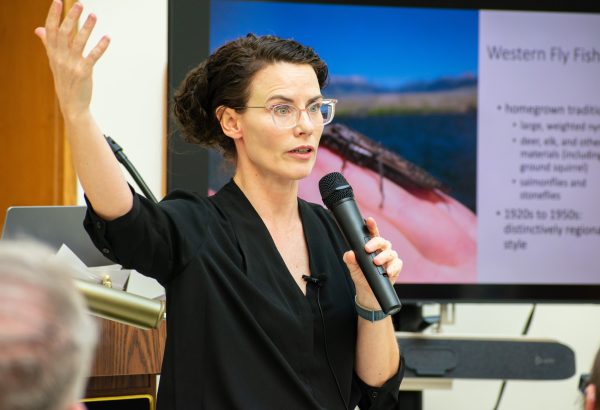WSU alumna, environmental historian is a storyteller at heart

Jen Corrinne Brown was known as WSU Libraries’ “fishing girl.”
She spent hours in Manuscripts, Archives, and Special Collections working on her dissertation in 2012, debunking fly-fishing myths about the Rocky Mountains.
“I’m just a storyteller at heart,” Brown said. “I want to tell stories that people think are interesting or might not know about.”
Fly fishing for rainbow, brown, and brook trout was popular in the West, but little did fishermen know that these trout were first introduced into the environment as non-native species from hatcheries. Brown said this impacted dam construction, conservation, and native species like the cutthroat trout. When cutthroat and rainbow trout mated, they could not reproduce, which caused the cutthroat trout population to plummet.
Questioning what is considered natural drove much of Brown’s research as an environmental historian, she said. It combined the Montana native’s love of the natural world and fishing, leading to her first book, “Trout Culture: How Fly Fishing Forever Changed the Rocky Mountain West.”
As Brown worked on her book, she fished in the Madison River. It was a chilly morning, and the sun peeked out from the clouds overhead. She marveled at the wild, undeveloped river where few other people were.
“I thought, ‘Oh my God, this is why I’m writing my book because it’s just so amazing,’” she said.
Brown also loves digging into archival materials and interviews from a different place and time. She said there is much more to learn from resources like WSU Libraries’ Gallup Collection compared to simply researching online.
Housed in MASC, the collection holds about 20,000 volumes on fly fishing, angling, and the environment. Brown said one can learn about the environment’s evolution from the 1400s to present day across multiple languages and cultures from this “treasure trove,” which is valuable for future fishery managers, environmentalists, and historians.
“It’s a rich, world-class collection, and I was really honored to be able to research it when I did my dissertation,” she said.
Brown gave a livestreamed lecture in the Terrell Library atrium in March based on five books in the Gallup Collection. They span the history of fly fishing, from its creation as a subsistence method to its evolution into a sport for European colonists.
One book in particular marks the shift between fly fishing as a subsistence method to a form of entertainment, and MASC holds 506 editions of the tome. “The Compleat Angler” by Izaak Walton, one of the most popular books published in English alongside the Bible, describes how European colonists established fly fishing as a rich, white man’s sport. It is intertwined with imperialism and industrialism, as fly-fishing tools shifted along with the power of fly fishermen to control conservation laws and Indigenous dispossession.
However, many popular fly patterns have Indigenous roots. Although settlers had power and control over both Indigenous people and resources, subsistence and sport traditions influenced fly fishing more than people may realize, Brown said.
“[Brown] demonstrates a model for how printed sources like this can become primary sources that lead to scholarship,” said Trevor Bond, associate dean for digital initiatives and special collections.
Little has changed in fish conservation efforts in the last 20 years, Brown said, but the future is bright for the West, given its strong, historical roots in conservation and fly fishing.
“I think a lot of the history of fly fishing is a history of people saving rivers and fish and endangered species,” she said. “That’s something that should be recognized in the larger history of the world.”